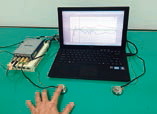

Human motor control, related cognitive processing, and establishment of support systems based on research findings
Human beings control their motion so flexibly and elaborately that even the most advanced robots today cannot faithfully reproduce their motion. In fact, many aspects of the motor control mechanism have yet to be elucidated. Recently, studies on motor control systems, which are comprised of hierarchical and redundant structures (including the brain), have thrived as an interdisciplinary endeavor covering a variety of fields, including medical science, biology, engineering, information science, psychology and social science.
The aim of this research group is to find ways to support social life through studies on motor control and cognitive processing. Although the group’s scope of research covers any topic serving this purpose, it is currently engaged in studies on the following three topics: (1) control of the position and force for our movement, including the maintenance of body balance, and related multisensory integration (support for people with impaired motor functions); (2) motor learning and motor adaptation in a redundant environment (support for the acquisition and improvement of movement skills); and (3) interpersonal coordination in joint action (support for neurodevelopmental disorders such as autism).
Associate Professor ABE, O. Masaki
Fascinated by the wonder of human body movement and its profundity, I have been engaged in studies on mechanisms behind human behavior and cognition with a focus on motor control. My recent research primarily focuses on the three following areas.
(1) Control of the position and force for our movement, including the maintenance of body balance, and related multisensory integration:
Proper control of the position and force for our movement is essential for our daily lives. In particular, the ability to maintain the balance of the entire body is important since it helps us prevent falls. I have explored the development of a safe, efficient system for evaluating balance maintenance ability by looking into postural sway characteristics and electromyogram patterns during quiet standing and walking. Going forward, I plan to examine more fundamental control of the position and force, not just balance maintenance ability, as well as study the mechanism behind multisensory integration of related information.
(2) Motor learning and motor adaptation in a redundant environment:
If you try to pick up a coffee cup in front of you, there are numerous positions your hand and fingers could take, as well as various combinations of joint angles, to achieve the task. Accurate understanding of how our nervous systems respond in this “redundant” environment (i.e., with numerous solutions to choose from) provides an important clue to promoting motor learning and motor adaptation. I have conducted theoretical and experimental studies on motor learning and motor adaptation processes in redundant goal-directed tasks (e.g., throwing tasks and bimanual force control tasks). In the future, I hope to further develop these studies to create theories and systems that will contribute to the acquisition and improvement of motor skills.
(3) Interpersonal coordination in joint action:
Issues in motor learning and motor adaptation occur not only during action performed by individuals but also during joint action, when two or more people perform a single task collaboratively or competitively. However, joint action often shows cognitive information processing differing from that for action by an individual. Clarification of such information processing and other mechanisms behind joint action is essential for understanding the mechanism behind interpersonal communication and for predicting or directing joint action. Furthermore, elucidation of related issues can provide useful insight into support for people with social adjustment problems. I have worked to enable the modeling of contribution by a pair of individuals during collaborative work by introducing a computational approach that has incorporated their autistic characteristics into a motor control optimization theory. My ultimate goal is to create strategies to predict and control the level of contribution by each person involved in joint action and to support efficient joint actions in society.